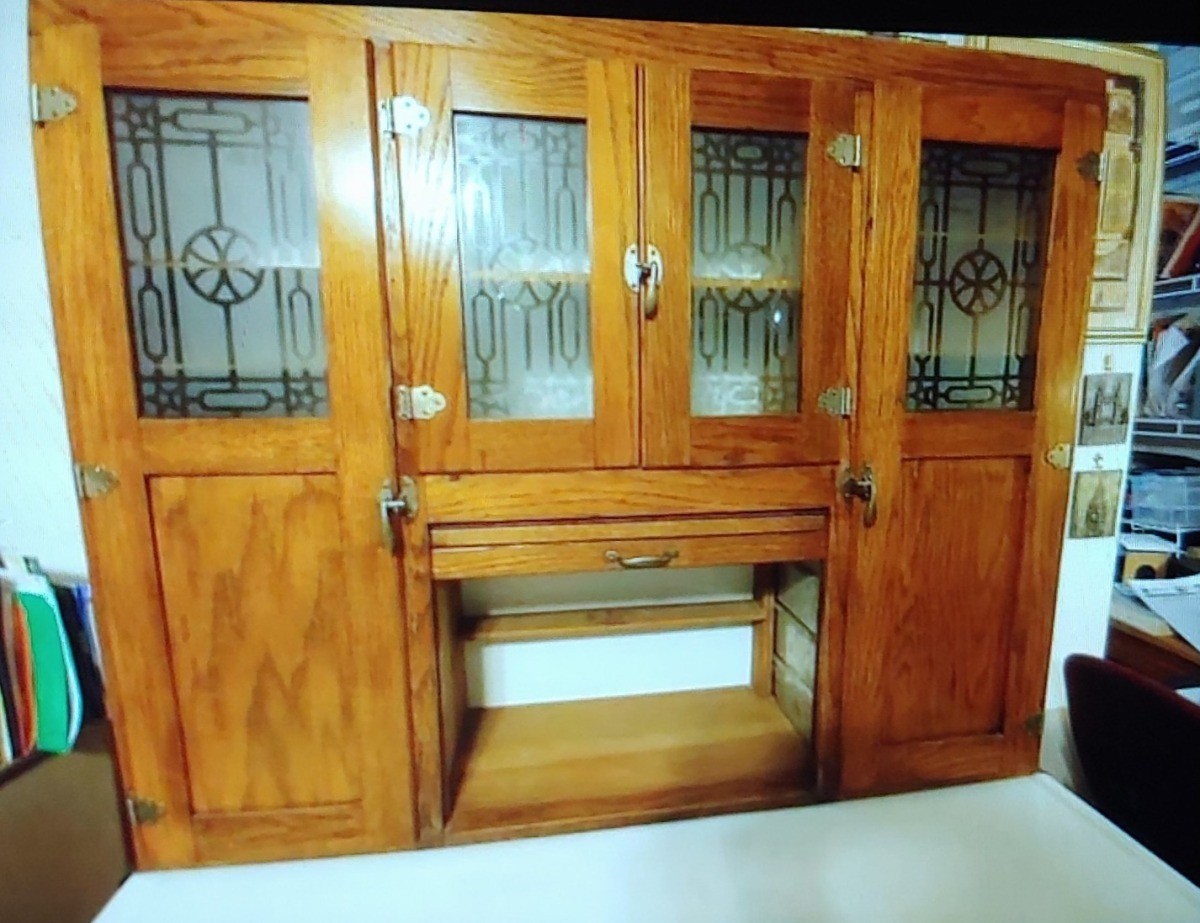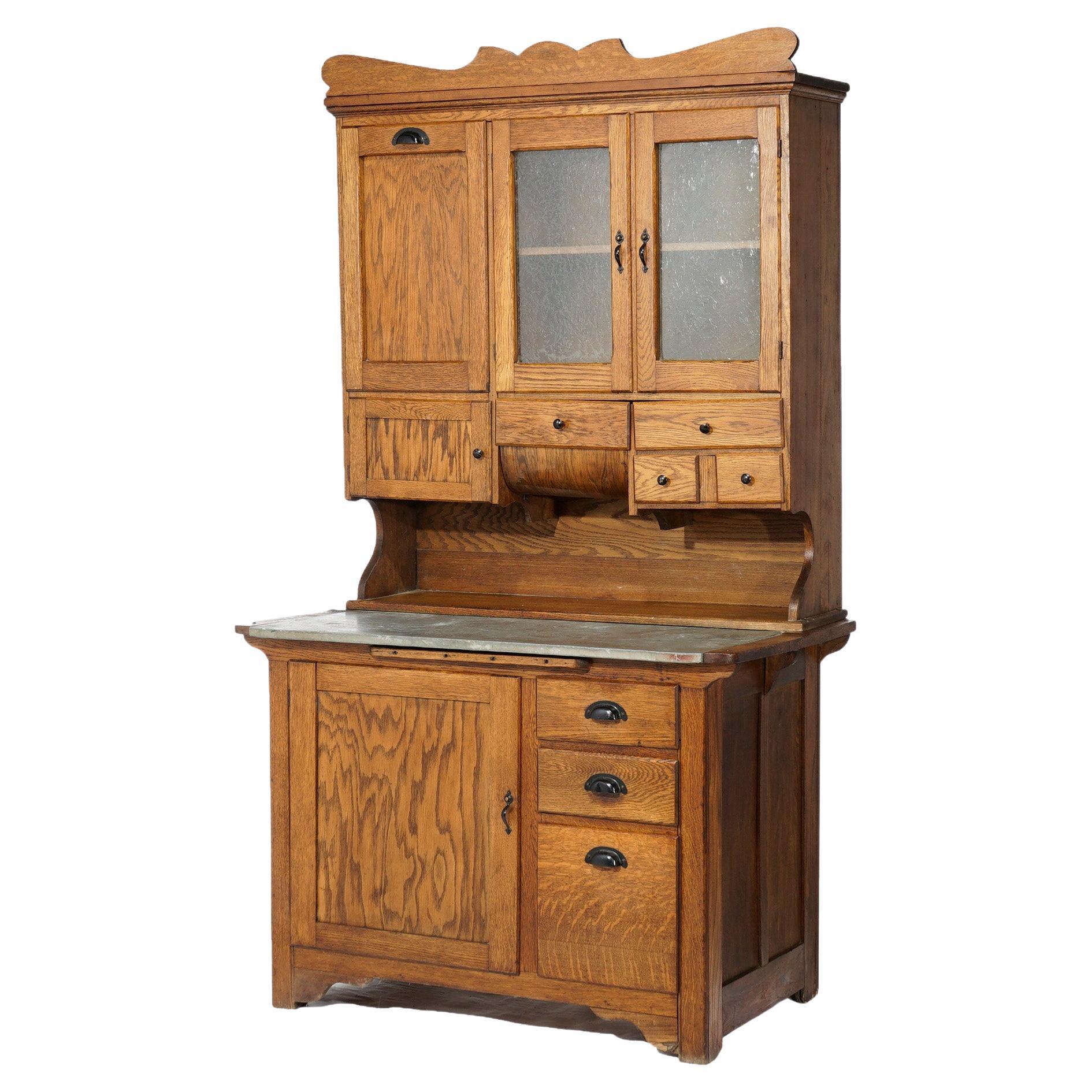The Hoosier Cabinet

The Hoosier Cabinet, a distinctive piece of furniture that graced kitchens across America in the 1920s, embodies the spirit of a nation on the cusp of change. This era, marked by rapid industrialization and social transformation, witnessed the rise of a new American dream, one that centered around the modern home and its efficient functioning. The Hoosier Cabinet, with its innovative design and practical features, perfectly captured the aspirations of this era.
The Hoosier Cabinet’s Place in the 1920s
The 1920s was a period of significant societal shifts. The Roaring Twenties, as it came to be known, was characterized by economic prosperity, technological advancements, and a burgeoning consumer culture. The rise of the automobile, the widespread adoption of electricity, and the burgeoning popularity of radio broadcasting transformed American lifestyles. The kitchen, once a laborious space, was poised for a revolution. The Hoosier Cabinet emerged as a symbol of this evolving domestic landscape, offering a solution to the challenges of modern life.
The Cultural Significance of the Hoosier Cabinet
The Hoosier Cabinet represented more than just a piece of furniture; it symbolized a cultural shift in the American home. It embodied the ideals of efficiency, practicality, and progress that were prevalent in the 1920s. As women increasingly took on roles outside the home, the need for a more streamlined and efficient kitchen became paramount. The Hoosier Cabinet, with its built-in flour sifter, sugar dispenser, and other ingenious features, promised to make cooking and baking a more enjoyable and less time-consuming task.
Reasons for the Hoosier Cabinet’s Popularity
The Hoosier Cabinet’s popularity in the 1920s can be attributed to several factors:
- Efficiency and Convenience: The cabinet’s built-in features, such as the flour sifter, sugar dispenser, and rolling pin rack, significantly reduced the time and effort required for food preparation.
- Modern Design: The Hoosier Cabinet’s sleek, streamlined design, with its white enamel finish and chrome accents, was in line with the modern aesthetic of the 1920s. It was a departure from the traditional, bulky kitchen furniture of the past.
- Affordability: Hoosier Cabinets were marketed as a relatively affordable option for middle-class families, making them accessible to a wide audience.
- Marketing and Advertising: The Hoosier Manufacturing Company, the original manufacturer of the Hoosier Cabinet, was adept at marketing its product through print advertisements and demonstrations, highlighting its efficiency and practicality.
Features and Functionalities of a Typical Hoosier Cabinet
A typical Hoosier Cabinet featured a range of innovative features that made it a versatile and practical addition to any kitchen.
- Flour Sifter and Sugar Dispenser: These built-in features streamlined the process of measuring and dispensing dry ingredients.
- Rolling Pin Rack and Cutting Board: The cabinet often included a dedicated space for storing rolling pins and a built-in cutting board, providing a designated work area for food preparation.
- Spice Racks and Drawers: The cabinet typically featured multiple drawers and spice racks, offering ample storage space for various kitchen essentials.
- Work Surface and Drop-Leaf Table: The Hoosier Cabinet often included a work surface that could be extended with a drop-leaf table, providing additional space for preparing meals or serving food.
- Sliding Doors and Cabinets: The cabinet’s design typically included sliding doors and cabinets, allowing for easy access to stored items and maintaining a clean and organized kitchen.
Design and Aesthetics of the 1920s Hoosier Cabinet: 1920’s Antique Hoosier Cabinet
The Hoosier Cabinet, a hallmark of the early 20th century kitchen, embodies the spirit of practicality and style that defined the Roaring Twenties. Its distinctive design elements, materials, and variations reflect the changing tastes and technological advancements of the era.
Distinctive Design Elements
The 1920s Hoosier Cabinet was characterized by a unique blend of functionality and decorative appeal. Key design elements include:
- Flour Bin and Sugar Bin: These were prominent features, often located at the top of the cabinet, with sliding lids for easy access to essential ingredients.
- Roll-Top Work Surface: This innovative feature provided a spacious work area that could be rolled up and down to reveal storage compartments underneath.
- Built-in Utensil Drawers: These drawers were strategically placed to hold various kitchen tools and utensils, promoting organization and efficiency.
- Pull-Out Cutting Board: This feature was typically located in the center of the cabinet, providing a convenient and stable surface for food preparation.
- Spice Drawers and Cabinets: These compartments were designed to house spices, herbs, and other ingredients, adding a touch of organization and elegance to the kitchen.
Popular Materials, 1920’s antique hoosier cabinet
Hoosier Cabinets of the 1920s were crafted from a variety of durable and aesthetically pleasing materials, including:
- Oak: This robust hardwood was a popular choice for cabinet construction, known for its strength, durability, and warm, natural grain.
- Maple: This hardwood offered a lighter, more refined appearance, with a slightly less pronounced grain than oak.
- Cherry: This hardwood provided a rich, reddish-brown hue, adding a touch of elegance to the cabinet’s design.
- Pine: This softwood was sometimes used for less visible components, offering a more affordable alternative to hardwoods.
Styles and Variations
Hoosier Cabinets in the 1920s showcased a range of styles, each reflecting the evolving tastes of the era:
- Mission Style: This style emphasized clean lines, simplicity, and functionality, often featuring a dark stain or finish.
- Arts and Crafts Style: This style celebrated handcrafted details, natural materials, and a sense of artistry, often incorporating decorative elements like hand-painted details or stained glass.
- Colonial Revival Style: This style drew inspiration from traditional colonial designs, featuring intricate moldings, decorative hardware, and a more ornate appearance.
Colors and Finishes
The colors and finishes applied to 1920s Hoosier Cabinets were a reflection of the era’s aesthetic preferences:
- Stained Finishes: Dark stains, such as mahogany, walnut, and ebony, were popular choices, adding a sense of sophistication and elegance to the cabinet.
- Painted Finishes: Light colors, such as cream, white, and pale blue, were also common, creating a brighter and more airy feel in the kitchen.
- Varnished Finishes: Varnishes were used to protect the wood’s natural beauty and provide a glossy sheen.
Hoosier Cabinets Today

The enduring popularity of Hoosier cabinets has extended into the 21st century, where they continue to be sought after by collectors, antique enthusiasts, and those seeking a touch of vintage charm in their homes. Their timeless design and practical functionality have ensured their relevance, making them not just pieces of furniture but cherished artifacts of a bygone era.
Restoring and Preserving a 1920s Hoosier Cabinet
Restoring a 1920s Hoosier cabinet is a labor of love that involves a meticulous process of cleaning, repairing, and refinishing. This process not only preserves the cabinet’s historical significance but also enhances its beauty and value.
- Cleaning: The first step is a thorough cleaning to remove dust, grime, and any accumulated layers of paint or varnish. This can be done using a soft cloth, mild soap, and water, followed by a gentle drying process.
- Repairing: Any damaged parts, such as loose hinges, cracked surfaces, or missing hardware, should be carefully repaired or replaced. This may involve using wood filler, glue, or specialized restoration techniques.
- Refinishing: Refinishing a Hoosier cabinet involves stripping away old layers of paint or varnish, sanding the surface, and applying a new finish. The choice of finish depends on the desired look and the condition of the cabinet’s original surface. Many restorers prefer to use a natural finish that highlights the wood’s grain and patina.
Market Value of Antique Hoosier Cabinets
The market value of antique Hoosier cabinets varies widely depending on factors such as condition, rarity, maker, and overall desirability. Well-preserved cabinets in original condition and from renowned manufacturers can fetch significant prices, particularly those with unique features or historical significance.
“The value of a Hoosier cabinet is not just determined by its age but also by its craftsmanship, condition, and the level of restoration it has undergone.”
Resources for Finding and Purchasing Hoosier Cabinets
Finding a Hoosier cabinet can be an exciting adventure, and there are several resources available for those interested in acquiring these iconic pieces of furniture.
- Antique Shops and Dealers: Local antique shops and dealers often have a selection of Hoosier cabinets available for sale. These shops offer a curated selection and can provide expert advice on condition and value.
- Online Auction Sites: Websites like eBay and Etsy are popular destinations for finding antique Hoosier cabinets. These platforms offer a wide range of options, from basic models to highly collectible pieces. It’s important to carefully review descriptions, photos, and seller feedback before making a purchase.
- Specialty Hoosier Cabinet Dealers: Some dealers specialize exclusively in Hoosier cabinets, offering a deep knowledge of the market and a curated collection of these iconic pieces. These dealers can provide valuable insights and assistance in finding the perfect cabinet.
Continued Appreciation for Hoosier Cabinets
The enduring appeal of Hoosier cabinets stems from their unique blend of functionality, aesthetics, and historical significance. They represent a time when kitchens were the heart of the home, where families gathered to cook, bake, and share meals. Their sturdy construction, practical design, and timeless charm continue to resonate with modern audiences, making them cherished pieces in homes and collections alike.
1920’s antique hoosier cabinet – The 1920s antique Hoosier cabinet, a testament to the era’s emphasis on functionality and craftsmanship, was a staple in many kitchens. These cabinets, with their signature flour-dusted surfaces and intricate details, provided ample storage for ingredients and tools. Similarly, the modern need for organized storage is met by a 100 pair shoe cabinet , which offers a dedicated space for footwear, keeping homes tidy and efficient.
While the Hoosier cabinet reflected the domestic priorities of the past, the 100 pair shoe cabinet addresses the modern need for organized storage solutions, showcasing how both eras prioritize practical functionality in different ways.
The 1920’s antique Hoosier cabinet, with its iconic flour bin and built-in work surface, embodies a bygone era of domesticity. These cabinets often featured glass doors, providing a glimpse into the contents within, a concept that echoes the modern appeal of a glass door white display cabinet.
While the Hoosier cabinet’s primary function was practical, its design elements, such as the ornate hardware and decorative flour bin, speak to the aesthetic values of the era, reminding us of the historical connection between function and form.
